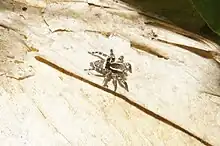Stenaelurillus wandae
Stenaelurillus wandae is a species of jumping spider in the genus Stenaelurillus that lives in India. It was first described in 2020 by Dmitri Logunov. The spider is medium-sized, with a carapace between 2.95 and 3.35 mm (0.116 and 0.132 in) long and an abdomen between 2.8 and 3.5 mm (0.11 and 0.14 in) long. The female is larger than the male. The colouration differs between them too, with the male having two white stripes on the carapace while the female has a pattern formed of brown and white scales. The chelicerae, clypeus, legs, pedipalps and spinnerets are generally yellow, although they may be yellow-brown on the male. The spider is distinguished from others in the area by the lack of a pocket in the epigyne of the female and the forked appendage, with different length tines, on the palpal bulb of the male.
| Stenaelurillus wandae | |
|---|---|
 | |
| A spider of the Stenaelurillus genus | |
| Scientific classification | |
| Domain: | Eukaryota |
| Kingdom: | Animalia |
| Phylum: | Arthropoda |
| Subphylum: | Chelicerata |
| Class: | Arachnida |
| Order: | Araneae |
| Infraorder: | Araneomorphae |
| Family: | Salticidae |
| Subfamily: | Salticinae |
| Genus: | Stenaelurillus |
| Species: | S. wandae |
| Binomial name | |
| Stenaelurillus wandae Logunov, 2020 | |
Taxonomy
Stenaelurillus wandae was first described by Dmitri Logunov in 2020.[1] It was placed in the genus Stenaelurillus, first raised by Eugène Simon in 1886.[2] The genus name relates to the genus name Aelurillus, which itself derives from the Greek word for cat, with the addition of a Greek stem meaning narrow.[3] The species is named after Wanda Wesołowska, the Polish arachnologist, in celebration of her 70th birthday.[4] The genus had been placed in the subtribe Aelurillina in the tribe Aelurillini by Wayne Maddison in 2015, who listed the tribe in the clade Saltafresia.[5] Two years later, in 2017, it was grouped with nine other genera of jumping spiders under the name Aelurillines.[6]
Description
The spider is medium-sized. The male has a yellow-brown carapace that measures 2.95 mm (0.116 in) in length and 2.05 mm (0.081 in) in width and is covered in scales forming a pattern of two white stripes along the top and yellow bands on the side. The abdomen is dark brown, 2.8 mm (0.11 in) long and 2 mm (0.079 in) wide, with yellow edges and greyish-yellow sides. The eye field is dark brown. The chelicerae is yellow and the clypeus is yellow-brown with white bristles. The spinnerets are brown, the legs are yellow and the pedipalps are yellow, with a brown tint to some of the extemities. The palpal bulb is rounded and has distinctive appendages. The embolus is slightly curved and has a large elongated base. It has a long retrolateral tibial apophysis, which is distinctively fork-shaped and distinguishes the species from others in the genus. The spider is similar to Stenaelurillus furcatus, which also has a long fork-like projection but the tines in this species are different lengths.[4] It also differs from other species in the area by its lack of a fringe.[7]
The female is similar to the male in shape but overall larger. The yellow carapace is 3.35 mm (0.132 in) long and 2.28 mm (0.090 in) wide and covered with brown and white scales. The abdomen has a length of 3.5 in (89 mm) and width of 2.8 mm (0.11 in). The chelicerae, clypeus, pedipalps, spinnerets and legs are all yellow. The epigyne is flat and has no pocket. The two copulatory openings are round and very close to each other. The insemination ducts are short, at the same depth as they are wide at the opening. The spider is unusual amongst Stenaelurillus species found in the region in that it lacks an epigynal pocket.[8]
Distribution
The species is endemic to India.[1] The holotype was identified based on a specimen collected in Odisha in 2014.[9] It was subsequently also found to live in Bihar.[10]
References
Citations
- World Spider Catalog (2023). "Stenaelurillus wandae Logunov, 2020". World Spider Catalog. 24.0. Bern: Natural History Museum. Retrieved 3 April 2023.
- Sudhin, Sen & Caleb 2023, p. 124, 132.
- Fernández-Rubio 2013, p. 125.
- Logunov 2020, p. 210.
- Maddison 2015, p. 279.
- Prószyński 2017, p. 95.
- Marathe et al. 2022, p. 16.
- Logunov 2020, pp. 210, 212.
- Logunov 2020, p. 212.
- Sudhin, Sen & Caleb 2023, p. 132.
Bibliography
- Fernández-Rubio, Fidel (2013). "La etimología de los nombres de las arañas (Araneae)" [The etymology of the names of spiders (Araneae)]. Revista ibérica de Aracnología (in Spanish) (22): 125–130. ISSN 1576-9518.
- Logunov, Dmitri V. (2020). "Further notes on the genus Stenaelurillus Simon, 1885 from India (Araneae: Salticidae)". Zootaxa. 4899 (1): 201–214. doi:10.11646/zootaxa.4899.1.11. PMID 33756833. S2CID 232339218.
- Maddison, Wayne P. (2015). "A phylogenetic classification of jumping spiders (Araneae: Salticidae)". The Journal of Arachnology. 43 (3): 231–292. doi:10.1636/arac-43-03-231-292. S2CID 85680279.
- Marathe, Kiran; Sanap, Rajesh; Joglekar, Anuradha; Caleb, John T. D.; Maddison, Wayne P. (2022). "Three new and notes on two other jumping spider species of the genus Stenaelurillus Simon, 1886 (Salticidae: Aelurillina) from the Deccan Plateau, India". Zootaxa. 5125 (1): 1–19.
- Prószyński, Jerzy (2017). "Pragmatic classification of the World's Salticidae (Araneae)". Ecologica Montenegrina. 12: 1–133. doi:10.37828/em.2017.12.1.
- Sudhin, Puthoor Pattammal; Sen, Souvik; Caleb, John T. D. (2023). "Two new Stenaelurillus species (Araneae, Salticidae, Aelurillina) from Western Ghats, India". Zoosystematics and Evolution. 99 (1): 123–133. doi:10.3897/zse.99.97985.